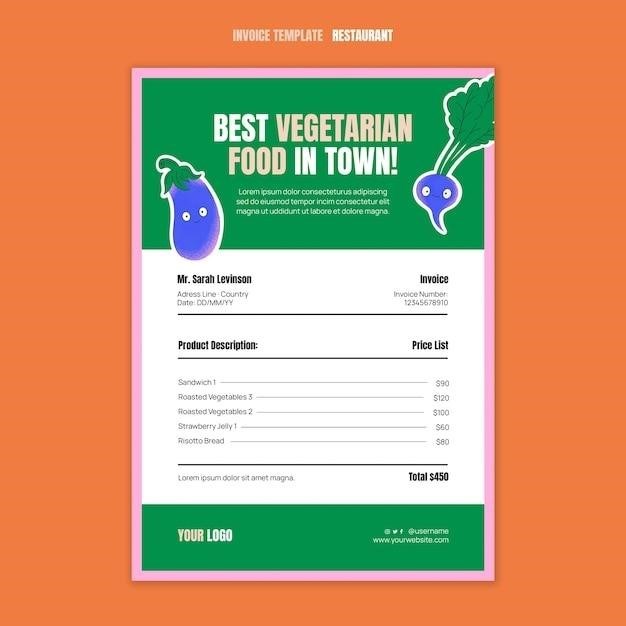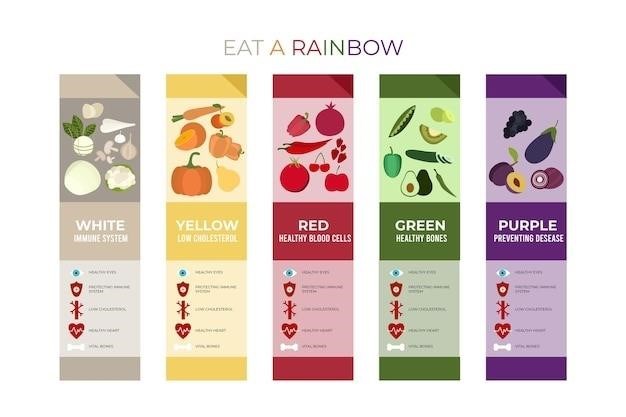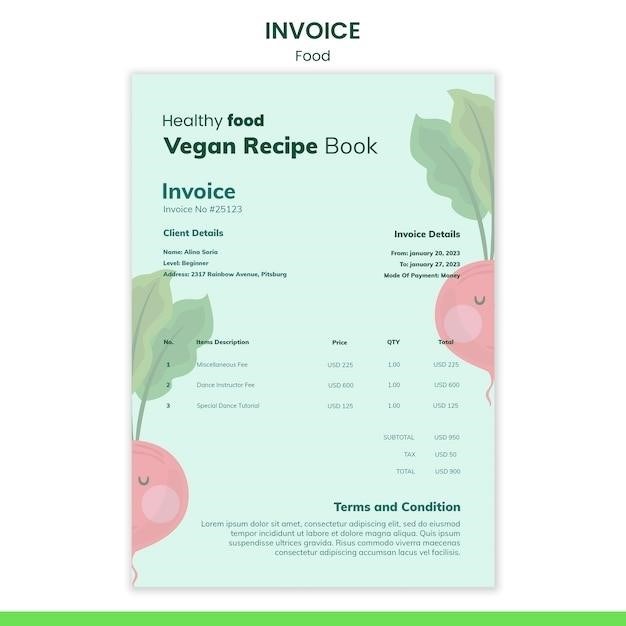
Lectin-Free Food List PDF⁚ A Comprehensive Guide
This guide provides a downloadable PDF with a complete list of lectin-free foods, categorized for easy shopping and meal planning. It includes vegetables, fruits, proteins, dairy alternatives, grains, nuts, seeds, and more. Helpful for those following the lectin-free diet.
Understanding the Lectin-Free Diet
The lectin-free diet, often associated with Dr. Steven Gundry’s “The Plant Paradox,” focuses on eliminating or minimizing lectins, a type of protein found in many plants. Proponents believe lectins can interfere with nutrient absorption, trigger inflammation, and contribute to various health issues, including digestive problems and weight gain. The diet’s rationale centers on reducing inflammation and improving gut health by avoiding foods high in lectins.
However, it’s crucial to note that the scientific community’s support for the lectin-free diet’s claims remains limited. While some studies suggest potential negative effects of certain lectins in high concentrations, a comprehensive understanding of lectins’ impact on human health is still developing. Many nutrition experts emphasize that a balanced diet incorporating diverse plant foods is generally beneficial, and restricting entire food groups might lead to nutrient deficiencies.
Therefore, individuals considering a lectin-free diet should consult with a healthcare professional or registered dietitian to assess their specific needs and potential risks. A personalized approach is essential to ensure adequate nutrient intake and prevent unintended health consequences. The diet’s restrictiveness necessitates careful meal planning and potential supplementation to avoid nutritional gaps.
Foods High in Lectins to Avoid
Many common foods contain lectins, and the degree to which they impact individuals varies. This list highlights those typically restricted on a lectin-free diet. Legumes, including beans (kidney, black, pinto, etc.), lentils, and peas, are often high in lectins, as are nightshade vegetables like tomatoes, potatoes, eggplant, and peppers. Grains such as wheat, corn, barley, and rye are also frequently avoided due to their lectin content, along with many pseudo-grains like quinoa.
Dairy products, particularly conventional cow’s milk (especially casein A1), can contain significant lectins. Certain nuts and seeds, while generally considered healthy, also merit consideration due to their lectin content. Processed foods and those containing added sugars should be minimized, as they often contain ingredients with high lectin concentrations. It is important to note that even seemingly healthy foods can contain lectins, emphasizing the need for careful food selection on this diet.
This list is not exhaustive, and lectin levels can vary based on factors such as the type of plant, growing conditions, and preparation methods. Cooking methods can affect lectin levels; however, some lectins remain resistant even after cooking. Always refer to a detailed and up-to-date lectin-free food list PDF for the most accurate and comprehensive information, and remember to consult with a healthcare professional or registered dietitian before making significant dietary changes.
Lectin-Free Vegetables and Fruits
Constructing a lectin-free diet often involves careful selection of vegetables and fruits. Many sources suggest that lower-lectin options include a variety of leafy greens such as spinach, kale, and romaine lettuce. Cruciferous vegetables like broccoli, cauliflower, and Brussels sprouts are often considered acceptable, although individual tolerance may vary. Root vegetables such as carrots, beets, and sweet potatoes are generally well-tolerated. Mushrooms are another generally suitable choice in the lectin-free context.
Regarding fruits, many berries (blueberries, strawberries, raspberries) are often included in lectin-free plans. Citrus fruits like lemons, limes, oranges, and grapefruits are generally considered acceptable, as are apples, pears, and avocados. However, it’s important to note that even within these categories, lectin content can vary depending on factors like growing conditions and ripeness. Pomegranates and certain melons are also often listed as lectin-free options.
It’s crucial to remember that individual responses to lectins can differ widely. While the above list offers generally accepted lectin-free choices, personal experimentation and monitoring of symptoms may be necessary to determine which specific fruits and vegetables best suit your individual needs and tolerance levels. Always consult a healthcare professional or registered dietitian for personalized dietary advice.
Lectin-Free Protein Sources⁚ Meat, Poultry, and Fish
For those following a lectin-free diet, animal proteins generally present a straightforward source of nutrition; Meat, poultry, and fish are naturally free from lectins, making them valuable components of a lectin-restricted eating plan. When choosing meat, poultry, and fish, it’s advisable to prioritize high-quality, ethically raised options whenever possible. Pasture-raised meats and poultry, for instance, tend to be richer in nutrients and may offer a more favorable nutritional profile compared to conventionally raised counterparts.
Specific examples of excellent protein sources within a lectin-free framework include grass-fed beef, free-range chicken, wild-caught salmon, and organic turkey. These choices often align with the principles of minimizing exposure to potential inflammatory compounds and promoting overall health and well-being. However, it’s essential to be aware of potential additives or processing techniques that might introduce lectins or other undesirable components. Processed meats, for example, may contain added sugars or other ingredients that are not consistent with a strict lectin-free approach.

To maximize the benefits of animal protein within a lectin-free diet, preparation methods should also be carefully considered. Simple cooking methods such as grilling, baking, or roasting are generally preferred over those involving extensive processing or the addition of lectin-containing ingredients. Always check labels and ingredient lists to ensure that your chosen protein sources align with your dietary restrictions.
Lectin-Free Dairy and Alternatives
Dairy products can be a complex area within a lectin-free diet. While some individuals tolerate certain dairy products without issue, others find that even organic dairy contains lectins, particularly casein A1. Therefore, many on a lectin-free plan choose to avoid dairy altogether or opt for carefully selected alternatives. Raw dairy is often cited as a potential source of higher lectin content compared to pasteurized options, although this remains a subject of ongoing debate within the scientific community.
For those seeking dairy alternatives, a range of plant-based options are readily available. Almond milk, for instance, is frequently favored due to its nutritional profile and relatively low lectin content. However, it is crucial to check labels carefully as many commercially produced almond milks contain added sugars and other ingredients that may not align with a strict lectin-free approach. Coconut milk, another popular alternative, can also be incorporated, but again, careful label reading is essential to avoid added sugars or thickeners.
Other plant-based options include various nut milks (such as cashew or macadamia) and some fermented dairy alternatives like kefir (made with goat’s milk or other lectin-friendly milk sources) although the lectin content can vary. Ultimately, the best approach is to carefully review product labels and choose options that are minimally processed and free from added lectins or other unwanted ingredients. Individual tolerance varies, so personal experimentation and observation of any digestive responses are also helpful. Remember to choose unsweetened varieties.
Lectin-Free Grains and Alternatives
Grains are a significant source of lectins for many individuals, making grain selection crucial on a lectin-free diet. Common grains like wheat, barley, rye, and even some rice varieties are often avoided due to their high lectin content. However, not all grains are created equal, and some are considered better tolerated than others within a lectin-restricted framework. The impact of lectins in grains can also vary based on processing methods. For example, sprouted grains may have lower lectin levels than their unsprouted counterparts.
Several grains are often included in lectin-free diets. These include sorghum, millet, fonio, and teff, which are generally considered lower in lectins. However, it’s important to remember that even these grains may contain some lectins, and individual sensitivities can vary considerably. It’s advisable to introduce these grains gradually into your diet to monitor any potential digestive reactions. Furthermore, the preparation method can influence lectin levels. Soaking and sprouting these grains can help reduce their lectin content further;
Beyond grains, numerous lectin-free alternatives exist. These include various pseudograins, such as quinoa (though some argue quinoa contains lectins) and amaranth. However, just as with grains, it’s important to consider individual tolerance levels and potential cross-reactivity with other foods. Additionally, other lectin-free carbohydrate sources include low-lectin vegetables like sweet potatoes and plantains. Careful selection and preparation are key to building a balanced and well-tolerated lectin-free diet that incorporates suitable carbohydrate sources.
Lectin-Free Nuts, Seeds, and Oils
Nuts and seeds, while often considered healthy, contain varying levels of lectins. Careful selection is important for a lectin-free diet. Some nuts and seeds are generally considered lower in lectins and better tolerated than others. However, individual reactions can differ, so it’s essential to monitor your body’s response to each type. Always introduce new nuts and seeds gradually to identify any potential issues.
Generally, nuts like almonds, macadamia nuts, and pecans are often included in lectin-restricted diets. However, peanuts, which are legumes, not nuts, are typically avoided due to their high lectin content; Similarly, among seeds, sunflower seeds, pumpkin seeds, and flax seeds are often considered suitable options. However, chia seeds and hemp seeds, while nutritious, may contain lectins and warrant cautious introduction.
Oils derived from nuts and seeds are usually acceptable in a lectin-free diet, provided they are unrefined and cold-pressed. These oils retain more of the beneficial nutrients and generally have lower lectin levels than refined options. Examples include avocado oil, olive oil, and macadamia nut oil. These oils offer healthy fats crucial for overall health and can be incorporated into various dishes. Remember to always check labels and choose high-quality, minimally processed oils to maximize their nutritional value and minimize potential lectin exposure.
Navigating Processed Foods and Beverages on a Lectin-Free Diet
Processed foods and beverages present significant challenges on a lectin-free diet. Many contain hidden lectins or other undesirable ingredients. Reading food labels meticulously is crucial. Look for products made with whole, unprocessed ingredients and avoid those with added sugars, artificial sweeteners, and refined grains—common sources of lectins and other inflammatory compounds. Even seemingly healthy options like some gluten-free products may contain hidden lectins or other additives.
Pay close attention to ingredient lists, searching for common lectin-containing additives such as soy lecithin, modified food starch, and various gums. Opt for minimally processed foods whenever possible. When selecting beverages, water, unsweetened herbal teas, and freshly squeezed fruit juices (if fruits are permitted in your individual plan) are generally safe bets; Avoid most commercially available juices due to added sugars and preservatives. Diet sodas and other artificially sweetened drinks are strictly off-limits because of potential additives and their overall impact on health.
Preparing meals from scratch is the best way to control lectin intake. This allows you to select ingredients carefully and avoid hidden lectins. Consider purchasing organic produce to minimize pesticide exposure. With careful planning and label reading, you can successfully navigate processed foods and beverages while adhering to a lectin-free diet, although it requires significant effort and attention to detail.

Printable Lectin-Free Shopping Lists and Resources
To simplify your lectin-free journey, utilize downloadable and printable shopping lists. Many websites and books offer these valuable resources, categorized by food groups for convenient grocery shopping. These lists often include both “yes” and “no” food sections, clarifying which items to include and exclude from your diet. Having a readily available list minimizes decision fatigue at the supermarket and helps maintain consistency.
Beyond shopping lists, explore online communities and forums dedicated to lectin-free living. These platforms provide support, recipe ideas, and additional resources. Consider consulting a registered dietitian or nutritionist specializing in lectin-free diets for personalized guidance and to address any concerns you may have. They can help you create a balanced meal plan that meets your individual nutritional needs while adhering to the restrictions of the diet.
Remember, a lectin-free diet can be restrictive, so professional support is vital to ensure you obtain all essential nutrients. Combining printable shopping lists with online resources and professional guidance empowers you to manage your diet effectively, making it easier to maintain long-term adherence and reap the potential benefits.